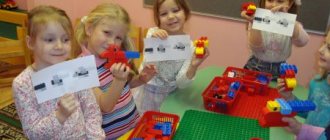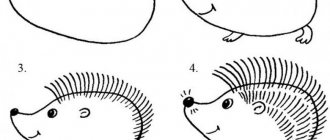Plot-based game lesson on rhythm for children 5-6 years old
Story-based game lesson on ri for children 5-6 years old
Rhythm lesson plan
Thematic game lesson “A trip to the forest”
The purpose of the lesson : to improve the emotional expressiveness of students by repeating and practicing the movements they have learned. Determining the level of program mastery. Objectives: • Fostering a love and interest in music, • Enriching children’s musical experiences by introducing them to a variety of musical works, • Introducing children to the simplest musical concepts, developing skills in the field of musical rhythmic movement, • Developing emotional responsiveness, sensory abilities and musical hearing, sense of rhythm, formation of expressiveness of movement, • Teaching elementary motor skills, achieving simplicity, naturalness and expressiveness in the performance of musical works, • Promoting the emergence and initial manifestation of musical taste based on received impressions and ideas about music, • Developing creative activity, independence and initiative in musical -rhythmic movement. Type of lesson: lesson on consolidating and improving knowledge, skills and abilities. Form of lesson: lesson Basic methods of work: - visual (practical demonstration);
- verbal (explanation, conversation); — gaming (game form of presenting material). Materials and equipment: - music center (TSO); - CD - discs with soundtrack - projector with forest slides Lesson progress:
Children entering the dance class.
Line up children in a checkerboard pattern. Bow to the teacher. Teacher: Hello guys, today we have an unusual lesson, where do you think we will go? (show illustrations) Children's answer: To the forest Teacher: That's right, to the forest. But first, guess the riddle of what we will go there on: I eat coal, I drink water. As soon as I get drunk, I’ll speed up. I’m carrying a train of one hundred wheels and I call myself... (steam locomotive) Children’s answer: Steam locomotive Teacher: That’s right, a steam locomotive. In order to get on the locomotive, we go to the station. We turn after each other. We walk, raise our knees high, and work energetically with our hands. (E. Zheleznova “Game gymnastics”) Teacher: Well, we came to the station and boarded the locomotive. We walk one after another, stamp our feet (the locomotive is moving), bend our arms and press our elbows to our chest (the wheels are spinning). When the locomotive picks up speed, we run after each other. (E. Zheleznova “Game gymnastics”) Teacher: So we came with you to the forest. So what do we see? Guess the riddle: Sisters are standing in the meadow: Golden eye, white eyelashes. (chamomile) Children's answer: Chamomile Teacher : Let's collect a bouquet? We walk one after another, take 2 steps, bend over and pick a flower. (E. Zheleznova “Game gymnastics”) Teacher : Well done, you got big bouquets. We listen to the riddle of who else we see in the forest: Who deftly jumps through the fir trees and flies up into the oak trees. Who hides nuts in a hollow and dries mushrooms for the winter? (squirrel) Teacher : That's right, squirrel. Let's play squirrels too. We make a large circle, press our arms in front of us (paws), nod our heads 4 times, do 8 springy squats, jump forward 3 times - we turn our backs to each other, 3 jumps forward - we turn to face each other. (E. Zheleznova “Game gymnastics”) Teacher : Well done. Listen to another riddle about who we see: A light, fast airplane flies over a fragrant flower. Wings, tail and eyes This is a miracle... (dragonfly) Children's answer: Dragonfly Teacher : That's right, dragonfly. Shall we play dragonfly? We turn around one after another, arms spread to the sides (wings), we run on our tiptoes, and at the end of the music we sit down on a flower. (E. Zheleznova “Game gymnastics”) Teacher: Well done. We get up and imitate the forest with you: The wind blows in our faces, They wave their hands in the direction “toward us,” like a fan,
The tree sways.
hands up, smooth tilts from side to side
The breeze is getting quieter, quieter
smooth movements of the arms forward - up - down
We will sit down lower, lower.
Squat Teacher: Guys, have you noticed frogs jumping here? Let's play frogs too? I.P. — Sit in one line, knees wide open to the sides, hands on the floor in front of you. 1-8 – head left and right 8 times, 1-4 – the first frogs jump up 5-8 – the second frogs; 1-4 – the first frogs get up, make 2 claps on the right side, sit down; 5-8 – make the second frogs, 2 claps on the left side; 1-8 - everyone makes 8 claps left and right together. When a new phrase begins, several frogs jump forward and fall asleep, and the game continues. (E. Zheleznova “Frogs”) Teacher : Well done. Do you guys know that animals also love to play? What are we going to play? Children's answer: In “Freeze” Description: Children run to the music, and when the music ends they freeze in a pose. The teacher asks one of the children to depict what he came up with. Teacher : Have you played enough? Well, now it's time to return home. We board the locomotive. Teacher: This concludes our lesson. Let's say goodbye. Children line up in a checkerboard pattern. Bow to the teacher. Children leaving the dance hall. List of literature for students: 1. Bochkareva, N.I. Development of children's creative abilities in rhythm and choreography lessons [Text]/N.I. Bochkareva. – Kemerovo, 1998. – 63 p. 2. Burenina A.I. Rhythmic mosaic. WITH . – Petersburg, 2000. – C5. 3. Burenina, A.I. Communicative dances - games for children: textbook / A.I. Burenina. – St. Petersburg: Publishing house “Musical palette”, 2004. 4. Kolodnitsky, G.A. Musical games, rhythmic exercises and dances for children / G.A. Kolodnitsky. – M.: Gnom-Press, 2000. – 61 p. 5. Pulyaeva L.E. Some aspects of the methodology of working with children in a choreographic group: Training manual. Tambov: Publishing house of TSU named after. G.R. Derzhavina, 2001. – 80 p. 6. Savenkov I.A. Gifted children in kindergarten and school, p. 5.
We recommend watching:
Summary of lessons on rhythm in the preparatory group Summary of educational activities for children of the senior group Summary of educational activities for introducing older preschoolers to the works of the poet Fet Summary of educational activities for children with mental retardation on the topic: Baby pets
Similar articles:
Lesson summary for the senior group on the topic “My Family”
Summary of a lesson on spiritual and moral education in the senior group
Thematic lesson in the senior group. Slavic mythology
Lesson on socio-communicative development and social education in the senior group
Lesson on etiquette and politeness in the senior group






